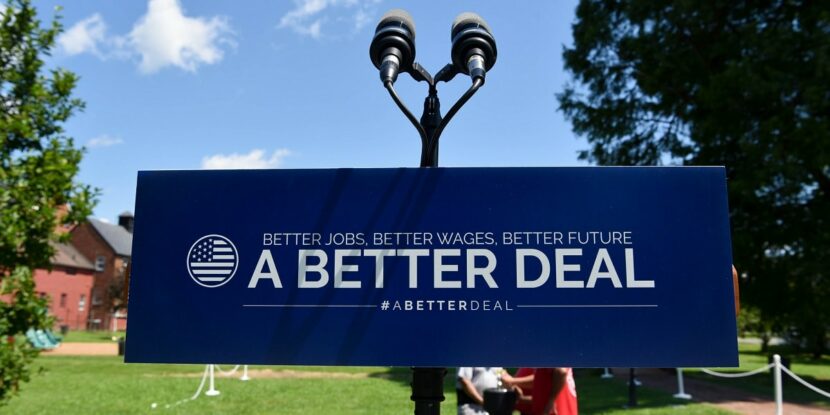Despite the media’s nonstop obsession with President Trump and Russia, the biggest political story so far this year remains the unbelievable impotence of the Democratic Party.
With a Republican President and a Republican Congress, the Democrats would seem to be in a historically advantageous situation — the President’s party traditionally struggles in midterm elections.
But as we have written previously, the “beleaguered” Democratic Party is in bad shape going into 2018. With just two or three genuine pick-up opportunities and more than a dozen seats at risk, the Senate is a virtual lock to stay under GOP control. Meanwhile, the House, where the Democrats’ ostensibly stand the best chance, is looking more and more like a long shot. Despite pouring tens of millions of dollars into special elections, the Democrats still haven’t managed to pull off a victory, which may have major implications on 2018, as I pointed out in June:
This House math looks an awful lot like the impossible Senate math. If the Democrats can’t win a race like the Georgia 6th — where Trump only won by 1.5 points in 2016, where they raised and spent more than $30 million, and where they had the opportunity to run against a Republican who didn’t have incumbency advantage — where are they supposed to win?
Losing the Georgia 6th district race was a huge blow. There are just 27 congressional districts represented by Republicans that are “more favorable” to the Democrats than Georgia’s 6th. In each of those races, the Democrats will be up against an incumbent Republican with a war chest of funds. The Democrats would need to win 24 of those races, win a few races in more Republican-leaning districts, and defend nearly all of their currently held seats in order to take control of the House. That’s a pretty tall order.
Many Democrats, who appear to be fully aware of their uphill battle to regain power, have recognized that their Russia-centric strategy hasn’t worked out too well so far in 2017.
As The Hill reported last month:
Democratic leaders have been beating the drum this year over the ongoing probes into the Trump administration’s potential ties to Moscow, taking every opportunity to highlight the saga and forcing floor votes designed to uncover any business dealings the president might have with Russian figures.
But rank-and-file Democrats say the Russia-Trump narrative is simply a non-issue with district voters, who are much more worried about bread-and-butter economic concerns like jobs, wages and the cost of education and healthcare.
In the wake of a string of special-election defeats, an increasing number of Democrats are calling for an adjustment in party messaging, one that swings the focus from Russia to the economy. The outcome of the 2018 elections, they say, hinges on how well the Democrats manage that shift.
Democratic leadership finally appears to be listening to those rank-and-file members. Yesterday, the Democrats unveiled their “Better Deal Agenda,” a “new” economic platform to run on as they pivot their messaging away from Russia-mania. Of course, I put “new” in scare quotes because the Democrats’ “Better Deal” messaging is the same messaging the Democrats have run on for decades: class warfare, economic populism, and identity politics.
As The New York Times reports:
The “Better Deal” agenda is filled with the kind of populist rhetoric championed by Trump — and progressive favorites Warren and Sen. Bernie Sanders (I-Vt.) — as it promises policies that aim to appeal to voter unrest over corporate “monopolies” and the “rigged” economy. It promises a government “on the sides of all Americans, not just those at the top.”
There’s literally nothing new here. Unwilling to offer anything substantive that could actually help grow the economy and increase wages for working class Americans, Democrats are resorting to the same old playbook in an effort to win back the large swaths of voters who deserted them in 2016: Tax hikes for rich people. Minimum wage increase to $15. More regulation. More government spending.
That isn’t likely to work. It’s not a “better deal” for working class people. Frankly, it’s not even “better messaging.”
This type of rhetoric might work well against a milquetoast corporate Republican like Mitt Romney, but it’s going to be hard for the Democrats — the party of corporate America — to compete with President Trump by trying to out-populism him.
Trump has already successfully convinced working class voters he cares about them, and many of his proposed economic policies — fixing broken trade policies that have cost tens of thousands of American manufacturing jobs; putting an end to the Chinese practice of dumping steel products on the American market below-cost in an effort to bankrupt American steel companies by triggering Section 232 of the 1962 Trade Expansion Act; reforming our immigration system to prevent undocumented workers from entering the U.S.; passing a worker-friendly tax reform package that will increase take-home pay for millions of Americans — are designed specifically with these voters in mind.
President Trump has dumbfounded the Democrats since the very first day he came down the escalator to announce he was running for president. This shift in messaging strategy — like their post-election shift to fake news, then to Trump’s tax returns, then to Russia — won’t make much of a difference.
Photo credit: Senate Democrats via Flickr, CC BY 2.0


